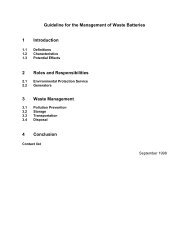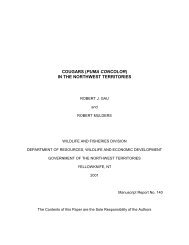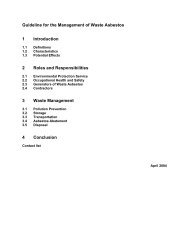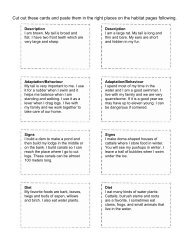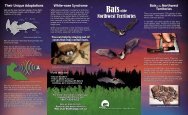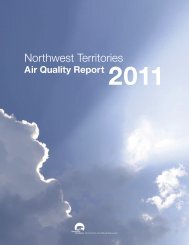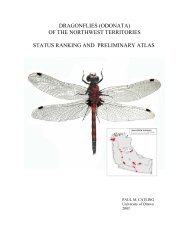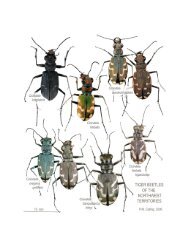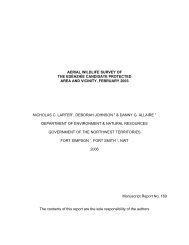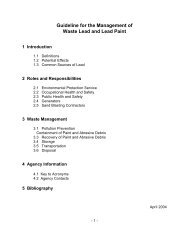Standard Operating Procedure (SOP) - Environment and Natural ...
Standard Operating Procedure (SOP) - Environment and Natural ...
Standard Operating Procedure (SOP) - Environment and Natural ...
- No tags were found...
You also want an ePaper? Increase the reach of your titles
YUMPU automatically turns print PDFs into web optimized ePapers that Google loves.
<strong>St<strong>and</strong>ard</strong> <strong>Operating</strong> <strong>Procedure</strong> (<strong>SOP</strong>)<br />
Capture, H<strong>and</strong>ling & Release of Bears<br />
Wildlife Care Committee Primary Author: Dr. Marc Cattet Version 2 - 2011<br />
first (heating pads, place in sleeping bag, drying wet hair coat), <strong>and</strong><br />
not administering a reversal drug until the body temperature has<br />
returned to within the recommended range.<br />
4.1.5 Recommendations for Monitoring of Physiological Function During<br />
Live Capture:<br />
The physiologic response to anesthesia must be monitored throughout<br />
h<strong>and</strong>ling until the bear is administered the reversal (antagonist) drug, or<br />
left to recover (if using Telazol or Zoletil alone). Assessments should<br />
be made <strong>and</strong> recorded every 10-15 minutes.<br />
Attention to physiologic function can provide advanced warning of developing<br />
complications (e.g., hyperthermia) <strong>and</strong> provide opportunity for preventative<br />
measures. Further, detailed records of physiologic function are an invaluable<br />
aid for investigation of any post-h<strong>and</strong>ling mortality.<br />
H<strong>and</strong>held blood monitors, e.g., iStat machines, can be used to monitor<br />
blood values to determine which bears may need increased monitoring<br />
immediately following recovery.<br />
A pulse oximeter should be included as a st<strong>and</strong>ard component of the<br />
capture equipment.<br />
It provides a useful means of evaluating respiratory <strong>and</strong> cardiovascular<br />
functions by measuring the hemoglobin oxygen saturation (in %) of blood <strong>and</strong><br />
the pulse rate (Allen 1992, Cattet et al. 2005, Kreeger et al. 2002, Reynolds<br />
et al. – unpublished report). Small, battery-powered, portable pulse<br />
oximeters are available commercially for use in the field. The recorded<br />
oxygen saturation values are often inaccurate for various reasons including<br />
calibration of the instrument for use in domestic species, decreased blood<br />
perfusion of peripheral tissues, variation in skin color, <strong>and</strong> variation in probe<br />
placement (Cattet et al. 1999, Hendricks <strong>and</strong> King 1994). However,<br />
monitoring for trends in oxygen saturation is valuable; if readings steadily<br />
decrease, it is likely the animal is in some sort of physiological crisis. When<br />
using a pulse oximeter, the probe should be applied at a consistent location<br />
(e.g., the tongue) <strong>and</strong> left in place until a stable signal is obtained before<br />
recording the oxygen saturation <strong>and</strong> pulse values. Concurrent evaluation of<br />
mucous membrane color will enable detection of hypoxemia, i.e., oxygen<br />
saturation is 85%, pulse rate increasing, <strong>and</strong> mucous membranes are<br />
becoming blue. Hypoxemia refers to low oxygenation of blood <strong>and</strong>, if<br />
prolonged, eventually leads to hypoxia, which is the diminished availability of<br />
oxygen in body tissues. Although the most obvious cause of hypoxemia is<br />
respiratory depression, it probably arises more frequently in captured wildlife<br />
as a consequence of elevated body temperature where the oxygen dem<strong>and</strong><br />
of body tissues exceeds the supply (Caulkett <strong>and</strong> Haigh 2004).<br />
Supplementary oxygen should be available to treat hypoxemia <strong>and</strong><br />
prevent hypoxia.<br />
Oxygen therapy is the most effective treatment for hypoxemia (Read et al.<br />
2001). Supplementary oxygen can be carried readily in the field in<br />
pressurized “D” cylinders (weigh approximately 6 kg when full <strong>and</strong> are safe to<br />
17



